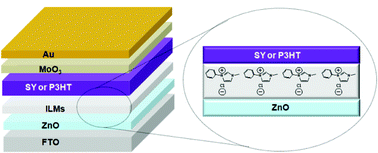Surface modification of metal oxide using ionic liquid molecules in hybrid organic–inorganic optoelectronic devices†
Abstract
We demonstrate enhanced device performance by surface modification of n-type ZnO using

* Corresponding authors
a
School of Mechanical and Advanced Materials Engineering, Ulsan National Institute of Science and Technology (UNIST), Banyeon-ri 100, Ulsan, Republic of Korea
E-mail:
mhsong@unist.ac.kr
b
Interdisciplinary School of Green Energy, Ulsan National Institute of Science and Technology (UNIST), Banyeon-ri 100, Ulsan, Republic of Korea
E-mail:
jykim@unist.ac.kr
c Department of Materials Science and Engineering, KAIST, Daejeon, Republic of Korea
We demonstrate enhanced device performance by surface modification of n-type ZnO using

 Please wait while we load your content...
Something went wrong. Try again?
Please wait while we load your content...
Something went wrong. Try again?
B. R. Lee, H. Choi, J. SunPark, H. J. Lee, S. O. Kim, J. Y. Kim and M. H. Song, J. Mater. Chem., 2011, 21, 2051 DOI: 10.1039/C0JM03688A
To request permission to reproduce material from this article, please go to the Copyright Clearance Center request page.
If you are an author contributing to an RSC publication, you do not need to request permission provided correct acknowledgement is given.
If you are the author of this article, you do not need to request permission to reproduce figures and diagrams provided correct acknowledgement is given. If you want to reproduce the whole article in a third-party publication (excluding your thesis/dissertation for which permission is not required) please go to the Copyright Clearance Center request page.
Read more about how to correctly acknowledge RSC content.
 Fetching data from CrossRef.
Fetching data from CrossRef.
This may take some time to load.
Loading related content
